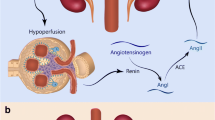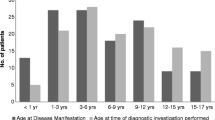Abstract
Background
Renal artery stenosis (RAS) causes significant hypertension in children. Frequently, pediatric RAS occurs with systemic disorders. In these cases, stenoses are often complex and/or include long segments. We believed that hypertensive children without comorbid conditions had a different lesion distribution and that the difference might have implications for imaging and treatment.
Objective
To identify locations of RAS lesions in these hypertensive children without comorbid conditions.
Materials and methods
Patients who had renal angiography for hypertension from 1993 to 2005 were identified. Patients with systemic disorders, renovascular surgery, or normal angiograms were excluded. The angiograms of the remaining patients were reviewed for number, type, and location of stenoses.
Results
Eighty-seven patients underwent renal angiography for hypertension; 30 were excluded for comorbid conditions. Twenty-one of the remaining 57 patients had abnormal angiograms; 24 stenoses were identified in those patients. All were focal and distributed as follows: 6 (25%) main renal artery, 12 (50%) 2nd order branch, 3 (12.5%) 3rd order branch, and 3 (12.5%) accessory renal artery.
Conclusion
Hypertensive children without comorbid conditions who have RAS usually have single, focal branch artery stenoses. This distribution supports angiography in these patients because of its superior sensitivity in detecting branch vessel disease and its therapeutic role in percutaneous transluminal renal angioplasty.





Similar content being viewed by others
References
Courtel JV, Soto B, Niaudet P, et al (1998) Percutaneous transluminal angioplasty of renal artery stenosis in children. Pediatr Radiol 28:59–63
McTaggart SJ, Gelati S, Walker R, et al (2000) Evaluation and long-term outcome of pediatric renovascular hypertension. Pediatr Nephrol 14:1022–1029
Vasbinder GB, Nelemans PJ, Kessels AG, et al (2004) Accuracy of computed tomographic angiography and magnetic resonance angiography for diagnosing renal artery stenosis. Ann Intern Med 141:674–682
Schoenberg SO, Knopp MV, Londy F, et al (2002) Morphologic and functional magnetic resonance imaging of renal artery stenosis: a multireader tricenter study. J Am Soc Nephrol 13:158–169
Hiner LB, Falkner B (1993) Renovascular hypertension in children. Pediatr Clin North Am 40:123–140
Hamilton SJ, Friedman JM (2000) Insights into the pathogenesis of neurofibromatosis 1 vasculopathy. Clin Genet 58:341–344
Bruno S, Remuzzi G, Ruggenenti P (2004) Transplant renal artery stenosis. J Am Soc Nephrol 15:134–141
Kolluri R, Ansel G (2004) Fibromuscular dysplasia of bilateral brachial arteries - a case report and review. Angiology 55:685–689
Deal JE, Snell MF, Barratt TM, et al (1992) Renovascular disease in childhood. J Pediatr 121:378–384
Shahdadpuri J, Frank R, Gauthier BG, et al (2000) Yield of renal arteriography in the evaluation of pediatric hypertension. Pediatr Nephrol 14:816–819
Mali WP, Puijlaert CB, Kouwenberg HJ, et al (1987) Percutaneous transluminal renal angioplasty in children and adolescents. Radiology 165:391–394
Bloch MJ, Basile J (2004) Clinical insights into the diagnosis and management of renovascular disease. Minerva Med 95:357–373
Garel L, Dubois J, Robitaille P, et al (1995) Renovascular hypertension in children: curability predicted with negative intrarenal Doppler US results. Radiology 195:401–405
Lagomarsino E, Orellana P, Munoz J, et al (2004) Captopril scintigraphy in the study of arterial hypertension in pediatrics. Pediatr Nephrol 19:66–70
Slovut DP, Olin JW (2004) Fibromuscular dysplasia. N Engl J Med 350:1862–1871
Vasbinder GB, Nelemans PJ, Kessels AG, et al (2001) Diagnostic tests for renal artery stenosis in patients suspected of having renovascular hypertension: a meta-analysis. Ann Intern Med 135:401–411
Tyagi S, Kaul U, Satsangi D, et al (1997) Percutaneous transluminal angioplasty for renovascular hypertension in children: initial and long-term results. Pediatrics 99:44–49
Cluzel P, Raynaud A, Beyssen B, et al (1994) Stenoses of renal branch arteries in fibromuscular dysplasia: results of percutaneous transluminal angioplasty. Radiology 193:19–21
Surowiec SM, Sivamurthy N, Rhodes JM, et al (2003) Percutaneous therapy for renal artery fibromuscular dysplasia. Ann Vasc Surg 17:650–655
Ishijima H, Ishizaka H, Sakurai M, et al (1997) Partial renal embolization for pediatric renovascular hypertension secondary to fibromuscular dysplasia. Cardiovasc Intervent Radiol 20:383–386
Kunzendorf U, Keller F, Schwietzer G, et al (1990) Control of renovascular hypertension by renal embolization. Am J Nephrol 10:339–343
Author information
Authors and Affiliations
Corresponding author
Rights and permissions
About this article
Cite this article
Vo, N.J., Hammelman, B.D., Racadio, J.M. et al. Anatomic distribution of renal artery stenosis in children: implications for imaging. Pediatr Radiol 36, 1032–1036 (2006). https://doi.org/10.1007/s00247-006-0253-8
Received:
Revised:
Accepted:
Published:
Issue Date:
DOI: https://doi.org/10.1007/s00247-006-0253-8




